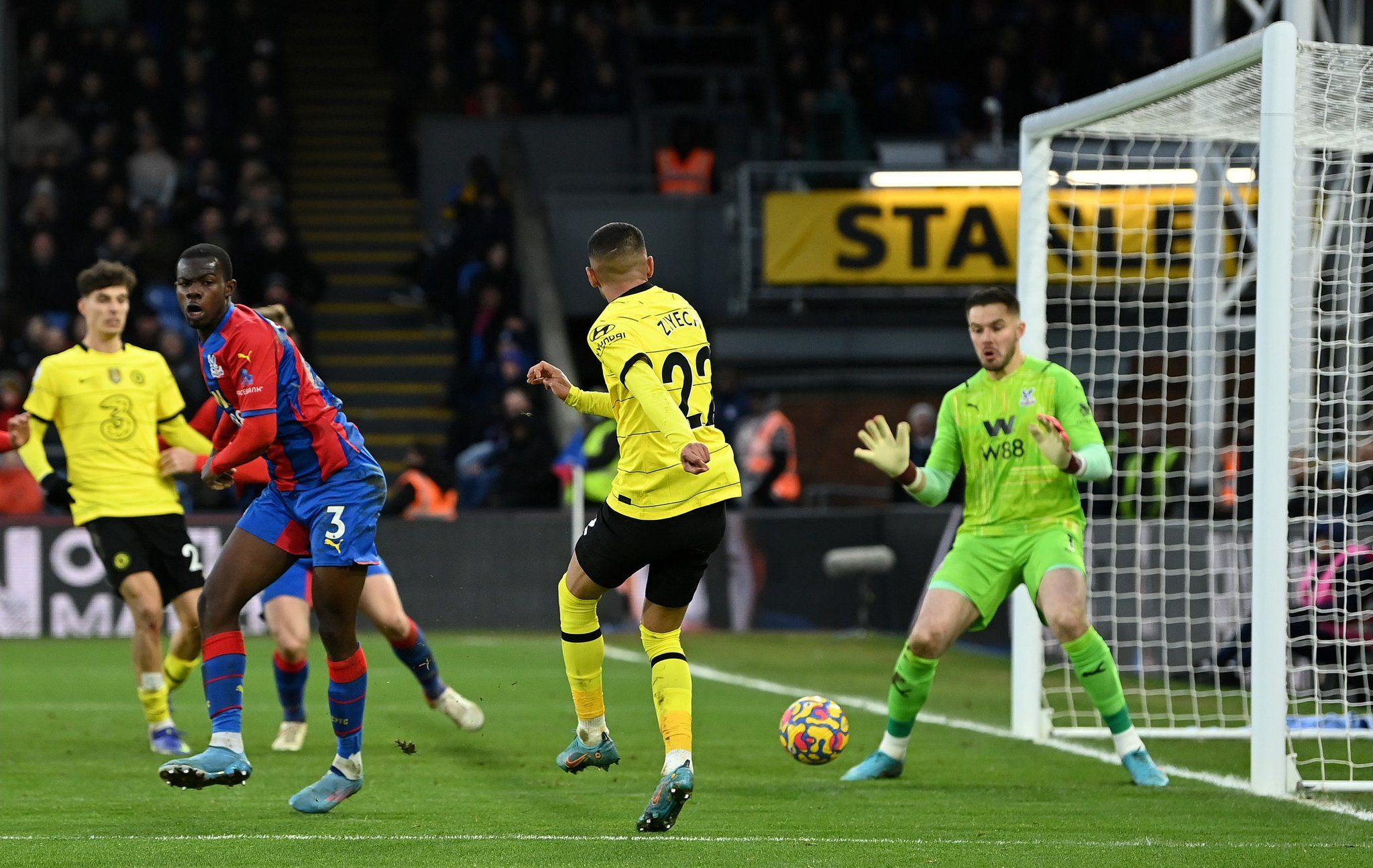
- Crystal Palace’s compact set up in defense
- Chelsea’s attacking approach in the first half
- Tuchel’s 2nd half change which won Chelsea the game
Crystal Palace’s compact set up in defense
Saturday’s Premier League clash saw a battle between Palace’s 4-2-3-1 and Chelsea’s 4-1-4-1.
Here, Vieira’s men matched Chelsea’s midfield (3v3) and width (1v1) (A), making them incredibly hard to break down. As a consequence, Chelsea failed to play out from the back as their midfield and attackers were completely man-marked (B).
How did Chelsea respond to this?


Chelsea’s attacking approach in the first half
If you look closely, it is Chelsea’s wide midfielders who were marked the least within this set up (C). Therefore, a way must be found to get the ball to these players as quickly as possible. To do so, Chelsea shifted to a makeshift back-3 with the sole purpose of creating more space for their wide midfielders to operate. How was this done? Using a 3-5-2 set up. Here, Chelsea recycled play amongst their 3 CBs with the sole intention of attracting Palace’s wingers forward (D). This created a plethora of space for our makeshift wingbacks, Sarr and Ziyech, to receive balls unmarked and cause damage (E).
Unfortunately, Chelsea were not able to capitalize on this situation. While Ziyech and Sarr tried to play medium-long passes in behind for runners (F), things were not clicking. Either passes were intercepted/played inaccurately, or there were inadequate numbers in support once the runner received the ball.




Tuchel’s 2nd half change which won Chelsea the game
In the 2nd half, we witnessed a change in tactics from Vieira’s men. Here, we saw Palace’s wingers sit back instead of pressing high. This helped reduce the space out wide which Chelsea operated within (G). In response, Chelsea reverted back to their original 4-ATB set up. This is as there was no need for 3 CBs if only being pressed by 1 Palace forward.
With Palace diminishing that space, Chelsea’s attack became diminished. It was at this point where Tuchel was forced to find a solution. Here, Chelsea changed to a 4-2-3-1 upon the introduction of RLC and Kovacic (H). With both 6’s being attack-oriented, Chelsea was able to create a more formidable wide overload to attack wide areas (I). Here, Chelsea was able to outnumber Palace’s wide defenders 3v2, in order to get in behind (J).
Once progressed, Palace’s both DMs were now spread thin and massive space was created between the lines. Here, the likes of Ziyech were able to cut in and cause havoc (K). Eventually, this took place on flanks, resulting in a 15-minute attacking display by Chelsea. Within this period, Chelsea was able to snatch a 89th minute victory via Hakim Ziyech, giving the blues a valuable 3-points after an unconvincing showing.





Where do we go from here?
With yet another late solution seeing Chelsea to a narrow win, it remains clear that our initial tactics are not sustainable. And, with the business end of the season approaching, it begs the question, where do we go from here?
In recent months, I have noticed a reluctance to achieve numerical superiority by Chelsea’s attackers. This can be attributed to not possessing the work-rate/intent to roam where needed to counteract oppositions’ defensive shape. When teams set up man-for-man against Chelsea (A-B), progression of play through quick, one-touch, attacking football is not possible. This is as we do not possess adequate numbers in attack, in close proximity to each other, through which such combinations can be facilitated. What does that leave us with?
It leaves sole responsibility to our attackers to beat their markers 1v1. Unfortunately, Chelsea’s attackers do not exert/possess this ability. Instead they back-pass upon receiving the ball, often resorting to playing around defensive lines instead of through them. This is why most Chelsea goals come from wide crosses and not through central combination play. If Chelsea are to become a top, possession-based side, they need to be able to do both playing through and around defensive lines. Every top possession-based side in the world possess players who completely own the spaces between the lines (L).
Specialists in these positions are players such as KDB, Bernardo Silva, Neymar, Messi, Salah etc. At the moment, Chelsea have no attackers who can successfully receive vertical passes between the lines, turn/take on markers and make line-breaking passes. Simply stated, our attackers do not possess the courage nor ability to operate between the lines under immense pressure. This neuters our ability to play through defensive lines, and leaves us with a one-dimensional approach of solely attacking around them. Unfortunately, our central deficiencies between the lines may soon make us predictable, risking further poor performances and losses in the future. At such an important time of the season, this is not acceptable.

Written by: Ryan Gunness








